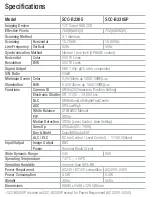
Honeywell Analytics
Fire Sentry Corporation
6349-001
Revision 1.2, Release Date: 15 February 2013
Page 5 of 16
2. DEVICE IDENTIFICATION
Manufacturer Name:
Honeywell
Analytics
Model Name(s):
FS24X
Manufacture ID Code:
210 (D2 Hex)
Device Type Code:
130 (82 Hex)
HART Protocol Revision
7.0
Device Revision:
1
Number of Device Variables
None
Physical Layers Supported
FSK
Physical Device Category
Sensor and Transmitter
The FS24X HART® module is identified by a serial number that begins with “24X-“. This
serial number will be visible on the module circuit card, along with a bar code containing the
same information.
The FS24X is designed to detect fire in a hazardous area. This device should be mounted so
as to avoid areas that contain non-fire radiant energy sources (such as radiant heaters, high
intensity lamps, etc.) in close proximity to the detector’s field of view. FS24X detectors
should be mounted so that they look downward with minimum twenty degree (20°) angle.
Avoid mounting the detectors in areas where temperatures are outside the specified operating
temperature range (-40°C to +85°C). Refer to the FS24X manual (SECTION 2:
INSTALLATION) for mounting instructions.
3. PRODUCT OVERVIEW
The FS24X is a Multi-Spectrum Flame Detector. A HART® communication module is
required for HART® communication.
4. PRODUCT INTERFACES
4.1
Process Interface
4.1.1
Sensor Input Channels
Fire Sentry multi-spectrum and multi-spectral infrared Flame Detectors are sophisticated,
state of the art, electro-optical digital radiant energy transducers that sense Wideband Infrared
radiant energy emitted by fire’s combustion processes that include molecular emissions and
hot particulate blackbody emissions
.
Additionally, the FS24X Detectors sense the specific
WideBand 4.3 IR “Triple IR” region from approximately 3 to 5 microns.
FS24X Detectors also utilize additional spectral regions, the Visible Band and Near Band
Infrared wavelengths, to aid in discrimination against non-fire false alarm sources.
4.2
Host interface
4.2.1
Analog Output 1: Loop Current
Loop current is the only output from this transmitter, representing the presence of flame in
the range of the instrument, as well as fault status. This output corresponds to the Primary
Variable. Refer to the section 4.3.3 for connection details.



































